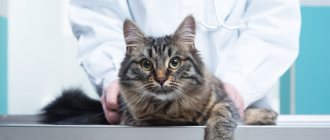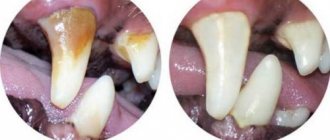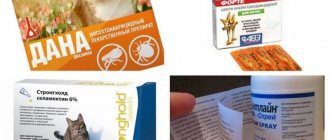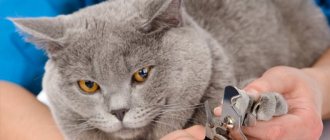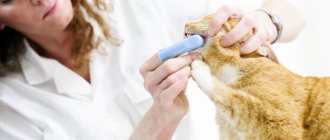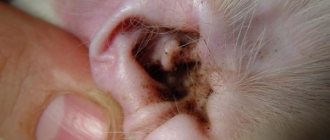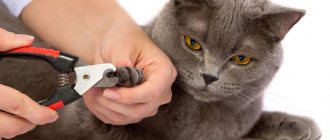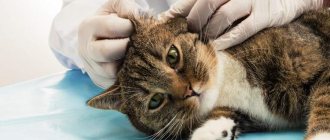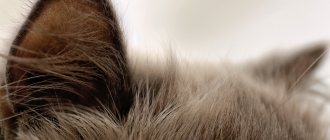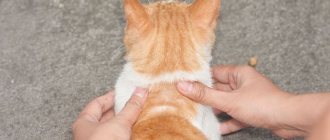Changes in a pet's behavior often alarm owners. Pets begin to scratch their ears and shake their heads. They lose their appetite. Discharge appears from the hearing organs, and the skin turns red. Such symptoms may indicate otitis media or tick infection. Ear drops for cats are selected depending on the causative agent of the disease. It is important to take measures in time so as not to start the disease.
“Anadin” drops are intended for the treatment of ear diseases in animals
Causes of the disease
Sometimes pet owners notice that the cat shakes its ear and scratches it very zealously. At the same time, it is clear even to a layman that she is very worried about this area. It is very dangerous to ignore such symptoms, since your pet can scratch the inner surface of the ear very strongly (to the point of bleeding). The result is non-healing inflammation, which often leads to blood poisoning.
The main factors that provoke ear itching:
- ear mites (otodectosis);
- hematoma after injury;
- fungus;
- abscess;
- otitis;
- eczema and dermatitis;
- foreign body;
- accumulation of sulfur;
- allergy.
Let's take a closer look at the most common reasons to understand why a cat scratches its ears and how to treat an animal for various diseases.
Prevention of ear inflammatory diseases
Almost all preventive measures to prevent the occurrence of inflammatory processes in the organ of hearing come down to the usual maintenance rules:
- periodically, but on an ongoing basis, inspect the ear canal of your pet and clean it of accumulated earwax with special means. There is no need to go deep into the ear canal. Preventive cleaning consists of cleaning only the inner surface of the auricle;
- Avoid keeping your cat in damp rooms for long periods of time, which may pose a risk of hypothermia;
- try not to get water into your ears while swimming (if this happens, it is recommended to blot the inner ear canal with a loose cotton swab);
- regularly carry out preventive treatment against fleas and ticks, and also exclude contact of your pet with yard and homeless people;
- carry out tick and flea treatment for all surrounding pets, as well as items for the care and maintenance of the pet.
Otitis is very dangerous due to its consequences. It is unwise to independently treat a pet, literally risking not only its health, but also its life.
Author:
Grinchuk Ekaterina Andreevna veterinarian
Ear mite
The most common disease that occurs most often in young cats and small kittens is ear scabies. Cleaning the ears will help detect this disease. If during this procedure you find a brown mass that also moves weakly, it means that the cat is tormented by ear mites (this mass is an accumulation of microscopic organisms). They cause severe itching in your pet.
In some cases, as a result of scratching, blood poisoning develops, which often leads to the death of the animal. But despite such dire consequences, a cat, after consultation with a veterinarian, can be successfully treated at home.
First of all, the mite mass, which usually collects in crusts, is removed from the ears. To do this, use a cotton swab dipped in any vegetable oil. When the ears are completely cleaned, they are treated from the inside with drugs such as Amitraz, Hexachloran, Tsipam, Amitrazine. The procedure is carried out five times every three days.
At the same time, apply ear mite drops (for cats) “Aurican” every day for seven days. Treatment is continued for a month, but the ears are instilled twice a week. The fur around the affected ear is moistened with Neostomazan solution. For preventive purposes, Stronghold, Bars, and Frontline are used. During the treatment period, the animal is isolated from contact with other pets.
Today there are many drugs for the treatment of this disease, so a veterinarian or a pet pharmacy worker will help you choose the appropriate ear mite drops for cats. In addition, the clinic may recommend natural remedies that are no less effective than chemicals that are contraindicated for kittens, pregnant cats and weakened elderly animals. In this case, the ears are treated from the inside with vegetable oil, and then 2-3 drops of camphor oil are instilled into each ear (including healthy ones).
Quite often, pet owners turn to veterinarians complaining that their cat is constantly scratching its ears. What to do in this case? A common cause of itchy ears in cats is otitis media, an inflammation of the ear. This disease is caused by the following reasons:
- foreign body;
- hypothermia.
This disease is manifested by the following symptoms that are difficult to miss:
- the cat scratches its ear;
- shakes his head;
- discharge appears from one or both ears.
But even if you independently discover, in your opinion, obvious signs of otitis, the final diagnosis should be made by a veterinarian based on research and test results. He will prescribe the necessary treatment.
Treatment procedures begin with rinsing the ears with 70 percent medical alcohol. Treatment of the disease depends on the location of the inflammation. The cat's hair inside the ear is cut off and the ear canal is treated with an alcohol solution (boric acid solution, iodine, hydrogen peroxide). Prednisolone is applied to the dried surface. The veterinarian will then usually prescribe antibiotics as well as antihistamines. If necessary, a novocaine blockade with an antibiotic is carried out, and fungicidal agents are used.
Pathological phenomena
Ear diseases in cats can begin due to damage during fights, viral or fungal infections, an allergic reaction or inflammation. The disease can affect one ear or both. Only a veterinarian can understand the cause of the disease after a thorough examination and testing.
Ear problems are divided into several groups:
- Non-contagious. These include processes not associated with parasites and infection. Among such pathologies are otitis media, hematomas and tumors.
- Infectious. The disease occurs against the background of the action of harmful microorganisms.
- Invasive. Discomfort in the hearing organs appears due to the activity of ticks, worms and other parasites in them.
Most often, ear problems in animals occur due to mites and otitis media. Ear parasites damage the integrity of delicate skin. These insects cause otodectosis, the advanced form of which is fatal. The disease is accompanied by swelling in the places where the tick parasitizes. This occurs due to blood vessels overflowing. The exudate released from the wound reacts with waste products of mites. As a result, a scab or crust forms on the damaged area.
Damage to the animal's ears should be examined to determine the cause of the disease.
The appearance of scabs gradually creates a plug in the ear. It can damage the integrity of the eardrum. This leads to the onset of an inflammatory process that penetrates into the inner ear. If treatment is not started, it can reach the pet's brain. Therefore, ear itching is dangerous for the life of the animal.
Otitis media comes in different forms:
- outer;
- average;
- inner ear.
It is important not to delay treatment of otitis, as a number of dangerous complications may arise.
The last type is recognized as the most dangerous. The disease can affect the vestibular system and brain. The disease can also be primary or chronic. Primary causes include autoimmune diseases, otodectosis, frequent bathing of the cat and improper ear hygiene.
At the appointment, the veterinarian conducts an examination and takes a swab from the hearing organs. Ear drops for the treatment of otitis are prescribed along with antibiotics and sulfonamides. If the disease is purulent, it is necessary to treat the shells with salicylic or boric acid.
Yeast fungus
When a cat scratches its ear, it cannot be ruled out that this is a serious disease, which is dangerous because a pathogenic environment is formed around the location of the lesion, favorable for infection with other infections. May cause hearing loss in the animal. It is quite difficult to diagnose on your own, but it is possible that very dark sulfur is accumulating inside the sink, which has an unpleasant odor.
Once a day, the sink is thoroughly cleaned with hydrogen peroxide until the cotton swab is white. During treatment, the antibiotic “Kabaktan” is used (intramuscularly) once a day for seven days. The immunomodulator "Maksidin" is administered subcutaneously or intramuscularly twice a day for five days. In addition, Otoferonol Gold drops are used. For prevention, Otibiovin is recommended.
List of drugs
The following dosage forms are used:
Ivermek-gel
The active ingredients are the acaricide Ivermectin, an analgesic and a wound healing agent. Both hearing organs are treated, even if only one is affected, 1…2 times, duplicating them after 5…7 days. Contraindicated for breeds sensitive to Ivermectin, convalescent and malnourished cats.
Amidel-gel
Active components - acaricide, analgesic, antimicrobial agent, auxiliary wound healing substances. Both channels are processed 1. 2 times, duplicating, after 5...7 days. Contraindicated in kittens up to 2 weeks old, convalescent, and sick.
Aversectin ointment
The active component is Aversectin. To clean the ear from crusts, additional means are needed - lotions or Perhydrol. The wool is cut. Apply the ointment, fold the shell in half, and massage the base of the ear. Contraindicated for breeds sensitive to Aversectin, kittens under 2 months old, lactation, convalescent, and sick.
Surolan
Aurikan
Amitrazine
Ear drops. The active ingredients are acaricide Amitraz and Dimexide, which have antiseptic, anti-inflammatory and analgesic properties. The ear is folded and massaged. Treatments are repeated every other week until symptoms disappear.
Ectodex
Ear drops based on Propolis and Sulfur. Preliminary cleaning of the ear canal from secretions is required. Treatment consists of two or three treatments every 5...7 days. The medicine is contraindicated for pregnant, lactating, and animals under one month of age. Do not use the drug if the integrity of the drum membrane is damaged.
Anandin plus
Ear drops. The main active ingredients are the acaricide Permethrin, the immunostimulant Anadin, and the antiseptic Gramicidin. Preliminary cleaning of the ears is carried out with the same drug used for treatment. The hearing organs are massaged after instillation of the medicine. Therapy lasts 3...7 days. If the use of Anandin is missed once, the course of treatment is resumed.
If the cat shakes its head, prevent droplets from splashing with restraint. Contraindication: violation of the integrity of the tympanic membrane.
Ear drops consisting of Amitraz and Prednisolone. The crusts are soaked with a swab soaked in Amit. Ears are treated twice a day. The course of treatment is 3...5 days. If a second infection occurs, change the drug. Contraindications: gestation, lactation, age less than 2 months.
Dekta
Ear drops consisting of Amitraz, Propolis and Dexamethasone. Apply once, with an interval of 5...7 days. Number of treatments 2…3. Contraindications: gestation, lactation, age less than a month.
Drops in the form of pipettes. The main component is the organophosphate disinfestant Diazinon.
After instilling the medicine, the ears are massaged. A week later, the treatment is duplicated. The medicine should not be used by pregnant or lactating animals, as well as animals under 10 weeks of age.
Mycodemocid
Drops. Consist of Sea buckthorn oil, Chlorophos, detergent Isopropyl alcohol. Treat once and repeat 7 days later if necessary. Contraindicated in pregnant and lactating animals, young animals under 10 weeks of age.
Ivermek-spray
Analogue of Ivermek-gel. Inject into the ears twice with an interval of 3...5 days. Put on the Elizabethan collar until the surface of the ear dries to avoid licking. The drug is not prescribed to animals under three months of age, lactating animals, matrons, and cats that are hypersensitive to Ivermectin.
Acaromectin
Active ingredient: Ivermectin. Moisten the affected area generously. The treatment is repeated after 8…10 days. Requires 3...4 injections. Before the wetted surface dries, put on the Elizabethan collar. Contraindicated in pregnant, lactating and under-one-month-old animals.
Neostomazan
An emulsion that is a means of killing insects. The contents of the ampoule (1 ml) are dissolved in 0.2...0.4 l of water and the ear canal is generously moistened. A week later, the procedure is repeated.
Dermatitis or eczema
Having diagnosed an animal with dermatitis or eczema, the veterinarian prescribes the following procedures:
- douching with soda solution, soapy water or hydrogen peroxide;
- removal of dead tissue;
- treatment of affected areas with astringents (“Pyoctanin”, picric acid, silver nitrate solution, “Albucid”);
- use of zinc oxide ointment;
- restorative therapy.
In especially severe cases, surgical treatment may be required - opening the lesions and removing the affected areas.
Treatment, prognosis
Treatment of otitis media is complex. It begins with the obligatory cleansing of the ears from secretions (exudate, dirt) and crusts. If you neglect this procedure, the medications will not have the desired effect. Antiseptics are used for this: 3% hydrogen peroxide; solutions of Furacilin or Miramistin.
In case of purulent otitis, a deeper cleansing of the hearing aid from pus will be required, which is performed surgically in a veterinary clinic.
Among the effective ear drops are Tsipam, Otovedin, Sofradex, etc.
For inflammation caused by ticks, the veterinarian prescribes acaricidal drops. Fungal otitis will require the use of ear fungicides. Antimicrobial ear drops and antibiotics are used to treat bacterial and purulent otitis.
For allergies and hormonal changes, antihistamines and corticosteroids are used.
Advanced stages of otitis require surgical intervention - an artificial puncture, as well as deep cleansing and powerful antibiotic therapy.
Other treatments for otitis media include pain relief. In some cases, the specialist decides to use novocaine blockade and introduce detoxifiers. Regardless of the form of otitis, vitamins and immunostimulants are prescribed to increase immunity.
As for the prognosis, in the vast majority of cases, with timely treatment, it is positive.
Beware: cat ears!
The hearing organs in cats play an even more important role than in human life. And although they are not limited to just the ears and pinnas, caring for them is the basis of caring for a cat's hearing. What to do for this?
The first thing you should do is check your pet's ears regularly. This procedure will not take much time, but the effect is simply enormous.
By spending a few minutes examining the ears, you can save yourself and your pet from unscheduled visits to the veterinarian and unpleasant and expensive treatment. This article will discuss ear diseases that are most common in cats, as well as brief recommendations regarding the treatment of these diseases.
Cats' hearing organs are sensitive and delicate. This biological device is both very complex and very vulnerable. You need to monitor this device very carefully, since ordinary otitis media, which has not been treated sufficiently, can affect the middle ear and result in deafness and loss of coordination of movements.
If a pet scratches behind its ear, then there is nothing abnormal in these actions. But if the cat scratches there constantly or even scratches itself, then this is a clear sign that you need to immediately consult a veterinarian. But before this happens, you can conduct an independent preliminary examination. Fortunately, nature has positioned cats’ ears in such a way that they can be examined without any effort.
In order to examine a cat's ears, you need to pick up the animal, caress it and wait until it is completely calm. After this, you need to pull the auricle back with two fingers - this will allow you to clearly examine the animal’s inner ear. If the inside of the ears are pink, do not have any abscess or plaque and are covered with light fluff, then everything is fine with them. But if there is something suspicious in this picture, a more thorough examination should be carried out.
Signs of diseases that you should pay special attention to
First: the ears are somewhat dirty, but there is no earwax in them
Take a piece of cotton wool and soak it in a weak solution of hydrogen peroxide, a special preparation for cleaning cat ears, or just warm water. Then gently wipe your pet's ear with this swab, being careful not to touch the ear canal. After this, the auricle should be wiped with a piece of dry cotton wool. Using soap or lotion for this procedure is strictly prohibited, especially if the lotion is alcohol-based. Both of these products will irritate your cat's skin too much.
If your cat constantly scratches behind the ear and shakes its head
Second: the cat constantly scratches behind the ear and shakes its head
The reason for this behavior may be a foreign body that has entered the auricle. If during the inspection you managed to notice it, try to carefully remove it using tweezers. If the object is firmly lodged in the ear, do not force it and contact your veterinarian. You should be as quick as possible, since a foreign body that gets into your pet’s ear can very quickly lead to otitis media.
If your cat's head is constantly tilted
Third: the cat’s head is constantly tilted and she scratches the skin behind her ear until she bleeds.
If ear scabies is not treated, it can very quickly develop into chronic otitis media. In addition, otitis media can cause a foreign body or fungus to enter the ear. In a mild form, the disease can be easily cured with special drops, but in a severe form, antibiotics will be required. An animal suffering from otitis media needs constant attention and special care. If your pet scratches itself badly, you should put a special collar on it.
Fourth: The pinna is hot, inflamed and red in color.
Most likely, these signs indicate ear hematomas (otematomas). If a blood vessel in the ear is damaged, it can cause internal bleeding. The result is severe bruising, although no external bleeding is observed. The cat begins to shake its head and scratch itself, which further complicates the disease. If the hematoma is small, it will be enough to take special medicine to make it resolve. But in more severe cases, surgery may be required.
A strong plaque was found in the ear
Fifth: during examination, a strong plaque was discovered in the ear
Plaque may indicate that the animal is suffering from ear scabies. This disease is not dangerous, but it is transmitted very well. In addition, it can affect not only cats, but also dogs, which transmit ear scabies to each other. The causative agent of the disease is a microscopic tick (Otodectes cynotis). First, it makes its way into the external auditory canal where it causes severe itching in the animal, which accompanies the appearance of an increased amount of dark brown earwax with an unpleasant odor. In this case, you need to contact your veterinarian so that he can select special ear mite expelling (acaricidal) drops for your cat. These drugs are very helpful in solving the problem of ear scabies. As always, treatment should not be delayed, as this disease can develop into something more serious.
How to put drops in your cat's ears correctly
If your veterinarian has prescribed ear drops for your pet, you will need to learn how to administer them correctly. To do this, you first need to prepare the auricle by gently wiping it with a damp cotton swab. After this, holding the tip of the ear with two fingers, pull it back, as is done during an ear examination, and drop the drops prescribed by your veterinarian into it. To help them penetrate deeper, lightly massage the outside of your ear. After this, you can safely release your pet.
And remember: if you do not neglect regular ear examinations, none of the above problems will have time to develop into something more serious.
The cat's ear is a hypersensitive device that can detect the finest shades of sound. Like any precision instrument, the ears need to be clean. Domestic cats groom themselves by instinct. But sometimes natural forces are not enough. And then the question arises: how to clean a cat’s ears.
A daily inspection will help you determine if your ears need to be cleaned. There is no need to once again interfere with the delicate balance of the body and the environment if the ears are pink, without odors, itching or discharge.
Healthy cats can have their ears cleaned 2-3 times a month without any medications or tools. A cotton sponge moistened with warm boiled water is enough. The mother cleans the kittens' ears.
Consequences of a dangerous disease
Otodectosis is distinguished by rapid development, but in its course there are still three stages. At each of them, several more are added to the list of symptoms.
First stage
The first stage lasts 4-5 days, already at this moment an attentive owner can notice that something is wrong with the pet. He begins to worry, scratching his ears because of itching, and the skin of the ear canal turns red.
Second stage
At the second stage, the following symptom is added to the itching and hyperemia of the ear: brown discharge and discharge. Earwax turns black and looks like ground coffee. The cat begins to itch more, sores form on the skin and become covered with crusts. An unpleasant odor appears.
Third stage
At the third stage, it is quite difficult not to notice the disease: the cat is depressed and lethargic. Often by this time, the entire muzzle, areas under the lower jaw and behind the ears are combed to the wounds.
We suggest you read: How to get rid of period in chickens using folk remedies and treatment with drugs
Note! Otodectosis can affect one ear, but not both, so you need to pay attention to the condition of each of them.
Despite its apparent harmlessness, this disease is dangerous and can lead to the following consequences:
- hematomas, eczema;
- pyogenic infection;
- convulsions;
- otitis – inflammation of the middle ear;
- inflammation or perforation (damage) of the eardrum;
- as a result, partial or complete deafness;
- fever;
- brain abscess;
- meningitis - inflammation of the meninges;
- coma;
- death.
The condition of the ears does not always depend on the cleanliness of the cat
Even if your pet goes to the toilet every day, thoroughly washing itself from the back of its head, its ears can get dirty. Here are some reasons why a cat has dirty ears:
- A cat cannot cope with external pollution on its own. This could be oil, fuel oil, powders or chemicals that accidentally settle on the surface of the ear. If there is no damage, only hygienic cleaning is required;
- Weather conditions sometimes affect the condition of the ears. Fold-eared cats need to have their ears checked more often. Try to prevent inflammation, use prophylactic medications for frequent use;
- A decrease in immunity associated with the disease can cause activation of pathogenic microflora of the ears. Hygiene and prevention are required, as well as improving the general condition of the body;
- An ear mite infestation always results in redness, itching, odor, and discharge from the ear canal. In this case, it is advisable to have an examination by a veterinarian;
- Otitis of any origin makes the ear visually dirty. The cat shakes its head, scratches and rubs its ears. The doctor will prescribe complex treatment.
If your cat needs help, you can tell by an unpleasant odor from the ears, copious amounts of yellow, brown or black discharge, redness, swelling and peeling of the auricle and visible ear canals.
Ear cleaning technique: persistence and caution
Before cleaning your cat’s ears, prepare the necessary tools: cotton or gauze sponges, ear cleaning lotion, prescribed medications. Do not use cotton swabs, tweezers, matches or other hard objects!
How to properly clean a cat's ears:
- Take the cat in your arms, calm it down, stroke the sides of the face, not the top of the head. This type of stroking imitates the feline element of communication and trust. Try to avoid using force. If the cat resists too desperately, make several approaches that imitate hygiene procedures. Do this every time before feeding or playing.
- Wrap a damp sponge around your index finger - this is the ideal tool for sensitivity. You only need to clean those areas that are visible and accessible without the use of tools. A few minutes before cleaning, you can drop a special lotion into the ear canal - this will help “lift” dirt from the depths of the ear and make it more pliable.
- Clean each ear with a separate wipe. Using movements from the inside out, you need to move the sponge from the inside of the ear to the outside. Try to carefully clean every wrinkle. Do not rub or press, especially if there is inflammation.
- After cleaning, you can put ear drops into each ear canal, even if there are signs of disease in only one ear. Also put 1-2 drops of the drug into the healthy ear. When the drop hits the ear curl, fold the ear in half lengthwise and massage the base of the auricle - this way the drug will spread better.
- Hold the cat for a while so that it does not shake itself off after the administration of the medicinal drug.
Applying eye ointment
Sometimes cats are prescribed treatment with eye ointment. To apply it, clean your cat's eyes (as with the drops). Then hold the “patient’s” head with one hand, while using your thumb and forefinger to pull the skin above the eyelid up. Take the tube with the drug in your other hand and, holding it parallel to the eyelid, apply the required amount of ointment. The strip of product should lie flat on the edge of the lower eyelid. Repeat the procedure for the second eye.
After this, slightly tilt the cat’s head and let him blink. Then gently massage your pet's closed eyelids - this will help the medicine to be evenly distributed over the entire surface of the eye.
During the procedure, be careful that the tip of the tube does not touch the cat’s eyeball.
Some tips for beginners
Be very careful when cleaning your kitten's ears. If it is inconvenient to do this with your finger, you can use cotton pads. To prevent ear inspection and cleaning from becoming stressful for an adult cat, start accustoming your kitten to them from early childhood.
To avoid having to hold the animal forcibly, choose a time for grooming between games and sleep. Sometimes during the day, pick up your cat and simulate brushing. Keep it short and always with a pleasant continuation (play, affection, feeding, walk).
If there is severe inflammation and pain, ask your veterinarian how to clean your cat’s ears correctly or ask a clinic specialist to do this the first few times.
A cat's protest regarding ear treatment should not be taken as a reason to appease your pet. The more you try to please, the more actively the cat will resist next time. When an animal is not healthy, treat its whims with indifference. Be methodical and friendly.
Cleaning cats' ears is an as-needed procedure. Healthy cats deal with dirt on their own. The owner only needs daily inspection and preventative cleaning as it gets dirty.
Features of breeds
Depending on the breed, there are different ear shapes: large and small, straight, hanging and folded. They do not have any special differences in the cleaning procedure, but there are some nuances that you need to know.
- The Sphynx and Siamese breeds have large, open ears and practically no protection from dirt and dust. It is these ears that tend to collect large amounts of debris and dust from the environment. Cleaning the ears of such cats will not be difficult, but the number of procedures can increase up to 2 times a month.
- Scottish Fold and Scottish Fold cats have drooping ears, which makes cleaning them a little more difficult. If in ordinary cats the condition of the ears is visible to the naked eye, then in such breeds it is necessary to carry out a special examination. This should be done when the animal is completely relaxed. Bend the ear and look for dirt and wax build-up. Scottish fold and fold-eared kittens have their ears cleaned in the same way as regular kittens, but you need to constantly “open” the ear.
For those who love Animals
Ear mites, or Otodectes cynotis, are microscopic parasites that can infest a cat's ears. Parasites prefer the warm, dark ear, where they feed on dead skin particles. These mites create irritation and itching, causing the cat to scratch and scratch at the ears.
Scratches from claws can, in turn, cause problems such as skin infections or swelling of the ear septum. The disease will not go away on its own, so the disease should be treated as early as possible.
In addition to the fact that itching causes suffering for cats, even more than fleas, if left untreated, otoacariasis can develop - an infection. The consequences can be serious. If left untreated, it damages the ear canals and eardrums.
Ear mites are highly contagious and can be passed from cat to cat or cat to dog and vice versa, so it is important to treat all of your pets at the same time.
How to tell if a cat has ear mites
Ear mites cause dark brown and sometimes black accumulations in the ear flaps that look like dirt. A cat with healthy ears will have clean inner surfaces.
If a dark coating is visible inside, similar to coffee grounds or black dirt, this is a sign of a possible ear health problem. When the disease occurs, an unpleasant odor emanates from the ears.
Ear mites cause irritation, so cats will try to scratch their ears with their back paws and often shake their heads, which can cause fluid to splatter from their ears.
A cat's claws, when scratched, can damage the surface of the skin, leading to bleeding and, in some cases, bacterial infections.
Cats that have suffered from ear mites for a long time may develop inflammatory polyps (bumps or growths) in the ear canals, which, due to constant rubbing and scratching, begin to bleed.
In addition, inflammation with purulent discharge may begin in the outer ear, with further rupture of the eardrum. At this stage, it is no longer possible to do without the intervention of a specialist - a veterinarian. So when the first signs of the disease appear, treatment should begin as quickly as possible.
If you have several animals and you suspect one of them has ear mites, check the ears of all animals, as ear mites can easily spread between animals, especially if they sleep, play or mate together.
If you see any of these signs, you should take your cat to a veterinarian for a check. Your veterinarian will usually use several methods to diagnose your cat's problem.
Examines the outer ear canal with a special tool, similar to a flashlight with a magnifying lens, that is used to look deep into the ear canal.
In some cases, your doctor will collect samples of earwax on a cotton swab and examine them under a microscope. Check to see if the eardrum is damaged and if there are any obstacles to the free flow of drops into the ear.
Next, the doctor will prescribe the right medicine depending on the severity of the disease, as well as the right dosage, so you should not self-medicate and buy medications from pharmacies yourself.
If you decide to buy the medicine yourself, before use, carefully read the label with instructions on how often to use the drops. The frequency of treatment and the number of drops will depend on the specific medicine, but as a rule, you need to drop 2 times with a break of 7 - 10 days.
Among the drops to combat ear mites, the most effective at the moment are oil-based Ectodes drops. Such drops better envelop the inside of the ear and do not spill out when cats start shaking their heads after instillation.
Before using the medicine, the cat's ears should be thoroughly cleaned of dirt with a cotton swab dipped in warm boiled water.
How to put drops in a cat's ears
It is better to carry out the procedure of cleaning the ears and instilling drops with someone together. If the cat resists strongly, wrap it in a towel to avoid being scratched.
Clean your ears, apply drops according to the instructions, gently press the ear with two fingers at the base and lightly rub between your fingers so that the medicine coats the inner surface of the ear.
Cats do not like this procedure, as the composition of the medicine can cause tingling of the bite wounds. After instillation, the cat begins to shake its head vigorously, so after instillation, try to hold the cat's head for a while.
Prevention
After treatment, you should constantly monitor the cleanliness of your ears. Clean regularly with a cotton swab and water. Inspect other animals living together, including dogs.
Use fipronil spray, which kills ticks, fleas, lice and other parasites. It is applied to the animal's hind legs and is an antiseptic when scratching the ears.
Consult your veterinarian for a prescription spray or substitute. This treatment will also destroy ticks that get on the fur when cats shake their heads and prevent re-infection.
Ear mites are not transmitted to humans, but they bring a lot of suffering and complications to animals, so prevention and timely treatment are the key to your pet’s health.
The ears of a cat, even a domestic one, are a very good dirt collector. True, a cat is a clean animal, and diligently cleans its face along with its ears when it washes itself. However, once they notice dark spots or gray stains of dirt on the inside of the ear, many owners wonder how to clean their cat’s ears at home and whether it can be done at all. This is especially of concern to those owners whose pets must participate in exhibitions where judges are very strict about appearance.
Ear drops for cats for otitis media
For ear pathology, the veterinarian will prescribe treatment after a thorough examination and diagnosis. The presence of otitis media can be determined by serous or purulent discharge, redness, itching, irritation or swelling of the inner cavity of the auricle. The animal shows anxiety; when trying to examine the ear, the cat meows loudly or screams in pain. Due to an increase in body temperature, the pet loses appetite, lethargy and apathy are observed. Modern anti-otitis drops for cats help cure your pet in a short time.
Aurikan
These ear drops are used for the prevention and treatment of otitis, otodectosis and hygienic treatment in cats. The active ingredients of Aurican are as follows (in 100 ml): diazinon - 0.05 g, prednisolone sodium sulfobenzoate - 0.03 g, tetracaine hydrochloride - 0.2 g, hexamidine diisethionate - 0.05 g. The drug is a slightly opalescent (with glow) transparent colorless liquid. Aurikan drops belong to combined preparations with antibacterial, acaricidal, anesthetic and anti-inflammatory effects.
The method of application is based on instilling 5 ml ear drops for cats into the ear canal, previously cleaned of crusts and exudate. No symptoms of drug overdose have been recorded. Contraindication is individual intolerance, hypersensitivity to any component. Do not allow the drug to come into contact with the mucous membranes of the nose and mouth or the conjunctiva of the animal’s eyes. The price of Aurikan drops varies from 450 to 500 rubles.
Otibiovin
These ear drops for cats contain the following active ingredients (per 20 ml): triamcinalone acetonide - 0.5 mg, gentamicin sulfate - 2 mg, salicylic acid - 5 mg. The medicine is a clear solution. This aminoglycoside antibiotic has a bactericidal effect on many gram-negative and some gram-positive bacteria. Salicylic acid has a disinfectant and soothing effect. Acetone triamcinalone is a corticosteroid that has an anti-inflammatory effect.
The medicine is instilled into the animal's ear canal several times a day. Initially, therapy 3-4 times a day, after three days the dosage is reduced to 2-3 approaches of 4-5 drops. Treatment lasts until complete recovery (approximately 5-7 days). Contraindications – rupture of the eardrum, individual intolerance to one of the components. The drug has restrictions on its use; the causative agent is first identified. The price of Otibiovin drops ranges from 300 to 500 rubles.
Otonazole
The active ingredients of this complex drug for cats (per 1 ml) are miconazole nitrate – 23 mg, prednisolone acetate – 5 mg, polymyxin bisulfate – 5500 IU. In appearance, the medicine is a white suspension. Otonazole drops have antimicrobial, anti-inflammatory, antifungal effects. The antibiotic in the drug acts on gram-negative bacteria.
The medicine is instilled 3-5 drops into the cat’s previously cleaned hearing aid. For better distribution of the drug, the base of the auricle is massaged with light movements for several seconds. After the disappearance of clinical signs, the medicine is used for another 2-3 days to consolidate the effect, but the course should not exceed two weeks. There are no contraindications for the drug; there are no side effects or complications. The approximate price of Otonazole drops is 230 rubles.
Why does a cat need clean ears?
No less often, cat owners wonder: why does a cat need such procedures at all, since he so thoroughly washes himself from head to toe with his tongue?
Indeed, a healthy cat who does not walk around the courtyards all day long does not need such regular torment. But if an attentive owner notices that his reveler cannot cope with the hygiene of this part of the body, and the dirt remains there, despite all efforts, the cat needs help.
It is also necessary to maintain external cleanliness of the ears for another reason: against the background of ordinary dirt and wax accumulation, the first symptoms of some diseases will not be noticeable, in particular, ear mites, which without a microscope look like ordinary pinpoint dirt. But you don’t need to overuse this procedure, and you should definitely learn how to properly clean a cat’s ears, because on your own, without the proper experience, you can cause the animal to suffer serious illnesses and injuries.
Medicine against otodectosis for the treatment of cats
First of all, acaricides are used:
- ear drops (“Aurican”),
- gels and ointments (“Amidel-gel”),
- aerosols (“Acaromectin”),
- drops on the withers (“Frontline”, “Stronghold”),
- systemic action in advanced cases (“Otodectin”).
In addition, the following may be useful:
- antibacterial agents (Sinulox, Doxycycline)
- antifungal in case of otitis (Clotrimazole, 1% Tolnaftate solution);
- antihistamines, if the cat is allergic to mite metabolic products and their bites (Suprastin, Tavegil);
- immunomodulators (“Fosprenil”).
Usually the animal is treated at home without being hospitalized. Tablets and ointments are fairly simple medications for self-administration. The veterinarian will suggest leaving your pet at the clinic only if the infection has affected the inner ear or meninges. In this case, the cat needs constant medical supervision, since its life is at risk.
Anti-otodectosis drops for cats are the most effective solution if you need to choose one acaricidal drug. To do this, 4-6 drops are injected into each ear. Treatment is carried out three times at intervals of a week.
Attention! Both ears are treated, even if otodectosis has spread to only one. Otherwise, the mites may migrate to another area, and you will have to start the whole treatment all over again.
The instructions for use of the drug indicate that side effects and complications during the use of antiparasitic ointment are diagnosed extremely rarely. Side effects occur with individual hypersensitivity to the components of the antiparasitic drug. Hypersensitivity to Aversectin ointment appears in the form of:
- the occurrence of hyperemia of skin areas;
- itching and burning;
- the appearance of blisters and bumps on the skin.
If characteristic signs of an allergic reaction appear, it is necessary to remove the composition from the pet’s body as soon as possible using dry wipes. Then you need to bathe the cat with warm water and shampoo. It is recommended to give your pet an antihistamine.
Contraindications to the use of Aversectin ointment are:
- acute phase of an infectious disease;
- the cat is underweight (emaciated);
- during gestation of kittens and during lactation.
Note! It is not recommended to use the ointment on small kittens under 2 months of age.
Everything is very simple
The main rule: at home you can only clean the surface of the outer ear. Under no circumstances should you climb inside, even with cotton swabs or chopsticks. The doctor, if necessary, sometimes uses tools similar to cotton swabs to reach dirt that is too deep in the ear. But this is a doctor, and the owners, as a rule, do not have such experience, and the result of an incorrectly performed hygienic procedure can be otitis media or injury to the inner ear.
First, you need to clean the surface of the ear with dry cotton wool to remove recently accumulated dust. Then slowly and carefully remove any dirt stuck to the skin with a moistened swab. There is no need to rush: you should definitely change the cotton wool as it gets dirty. Do not twist the ear too much.
Some owners mistakenly believe that before treating the auricle they need to instill some kind of solution there. This is not required to clean the skin. It’s another matter if the veterinarian prescribed special means for prevention, but they must be instilled only after cleaning, otherwise the product will be less effective, since dirt will not allow it to reach the skin.
Photo of otitis media in a cat
| Parasitic otitis media | Allergic otitis media |
| Fungal otitis media | Pemphigus foliaceus |
| External superficial otitis | Tumor otitis media |
| Increased hair growth | Purulent-bloody discharge |
Swab or cotton swab?
The debate about which tool to clean ears is still going on. Many people are especially interested in the problem: is it possible to clean cats’ ears with cotton swabs?
The outer ear can be treated with any instrument that can be wrapped with cotton, including cotton swabs. But sharp instruments are not the best option, because the animal does not like to sit still for a long time, and a person can turn around and injure his pet or accidentally get deeper than he should. There is less risk with a cotton swab.
The structure of the auricle
Cats' ears are slightly reminiscent of human ears in structure. They also have an outer, middle and inner ear. We will not go deeper and will study only what we need, namely the outer ear, up to the eardrum.
The cartilage of the outer ear is covered on the inside with very delicate skin with a small amount of hairs, and on the outside with hair. The auricle that we see smoothly passes into a canal with very thin skin, pink in color. At the end of this canal is the eardrum.
The structure of the auricle does not allow a person to clean their ears deeply. We can only influence its visible part.
Treatment products: which ones are better?
There is still no consensus among cat owners about which products are best. There is no definite answer; each cat in this case requires an individual approach.
- Hydrogen peroxide perfectly cleanses the surface of sulfur, dissolving it, and also promotes the rapid healing of microtraumas, thanks to its hemostatic effect.
- Chlorhexidine has less cleaning power, however, its antibacterial properties are much higher.
- Special oils, which are easy to buy at any veterinary pharmacy, are good because after the procedure they form a thin film that softens the skin after treatment, but they also have a drawback - the ears get dirty faster after such a procedure.
If it is not possible to purchase the listed products, ordinary vegetable oil or plain water will do, but they must be clean, ideally they should be boiled and cooled. It should be remembered that all these products should be used to moisten a cotton swab, and not instilled into the ear.
How often is this needed?
Another serious point: the regularity of such hygiene procedures. And this is sometimes much more important than the task of learning how to clean a cat’s ears. The main thing in this matter is a sense of proportion. Excessively frequent hygiene procedures will lead to faster contamination, because the skin of the cat family has the ability to self-clean well and the slightest disturbance in the water balance can lead to disruption of skin functions. It is believed that such procedures should be carried out no more than once a week, ideally only when soiled. But for some breeds, for example, for Sphynxes, daily hygiene procedures are necessary, since their skin functions are atypical.
Psychological preparation
A cat's ears are one of the most sensitive places, and most cats absolutely do not like this hygiene procedure. Therefore, at home, it is more important not how to clean a cat’s ears, but how to accustom her to this. And this must be done from childhood. The animal must trust the owner and not be afraid when he carefully strokes or touches the ears.
But if the animal does not want to sit quietly, then it should be well restrained. You may need the help of an assistant who will hold the cat: after all, both hands are needed to properly clean the ears.
How to put drops in a cat's eyes
Before the procedure, clean the cat's eyes by removing discharge with a cotton swab dipped in clean, warm water. Warm the medicine to be instilled in your palms.
Ask someone at home to help you. Have a helper hold your pet's front paws. Take the drops in one hand. Use your other hand to hold the cat's chin.
If the cat closes its eyes, you can move the skin above the eye up and pull it back a little with the hand you are holding the animal's head with. Drop the required amount of medicine. Then tilt the cat's head slightly so that he can blink and the medicine is distributed over the eyeball.
If you have to carry out the procedure yourself, first wrap your pet in a blanket or towel and lay it on its side.
